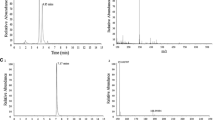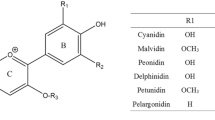Abstract
Background
Procyanidins are extensively metabolized via phase-II and microbial enzymes. However, their distribution in the body is not well characterized.
Aim
This study investigates the distribution of procyanidins (monomers and dimers) and their phase-II metabolites in plasma and tissues (thymus, heart, liver, testicle, lung, kidney, spleen and brain).
Methods
Wistar rats were fed with 1 g of cocoa cream (CC), 50 mg of procyanidin hazelnut skin extract (PE) and 50 mg PE in 1 g CC (PECC). The rats were killed at 0, 1, 1.5, 2, 3, 4 and 18 h after gavage, and the plasma and tissues were analyzed by UPLC–MS/MS.
Results
Epicatechin–glucuronide was the main metabolite in the plasma after the CC intake, with C max at 423 nM and t max at 2 h, and methyl catechin–glucuronide (301 nM, 2 h) was the main metabolite in the plasma after the PE intake. As a result of the PECC enrichment, epicatechin–glucuronide (452 nM, 1.5 h) and catechin–glucuronide (297 nM, 2 h) were the main metabolites in the plasma. Methyl catechin–glucuronide was found in the liver after PE (8 nmol/g tissue, 4 h) and PECC (8 nmol/g, 1.5 h). The kidney was found to contain a high concentration of phase-II metabolites of procyanidins and is therefore thought to be the main site of metabolism of the compounds. Methyl catechin–sulfate (6.4 nmol/g, 4 h) was only quantified in the brain and after PE intake. Catechin metabolites were not found in the spleen or heart. Phenolic acids were detected in all tissues.
Conclusions
The formulation of a product enriched or fortified with procyanidins is a way to increase their bioavailability, with clear effects on the plasmatic pharmacokinetics, and a greater accumulation of phenolic metabolites in such tissues as the liver, kidney, lung and brain.





Similar content being viewed by others
References
Allen L, de Bonist B, Dary O, Hurrell R (2006) Guidelines on food fortification with micronutrients. WHO Press, Switzerland
Kaur S, Das M (2011) Functional foods: an overview. Food Sci Biotechnol 20:861–875
Hasler CM, Brown AC (2009) Position of the American Dietetic Association: functional foods. J Am Diet Assoc 109:735–746
Faridi Z, Njike VY, Dutta S, Ali A, Katz DL (2008) Acute dark chocolate and cocoa ingestion and endothelial function: a randomized controlled crossover trial. Am J Clin Nutr 88:58–63
Gupta AK, Savopoulos CG, Ahuja J, Hatzitolios AI (2011) Role of phytosterols in lipid-lowering: current perspectives. QJM 104:301–308
Franck A (2006) Oligofructose-enriched inulin stimulates calcium absorption and bone mineralisation. Nutr Bull 31:341–345
Bosscher D, Van Loo J, Franck A (2006) Inulin and oligofructose as functional ingredients to improve bone mineralization. Int Dairy J 16:1092–1097
Grassi D, Desideri G, Necozione S, Lippi C, Casale R, Properzi G, Blumberg JB, Ferri C (2008) Blood pressure is reduced and insulin sensitivity increased in glucose-intolerant, hypertensive subjects after 15 days of consuming high-polyphenol dark chocolate. J Nutr 138:1671–1676
Schroeter H, Heiss C, Spencer JPE, Keen CL, Lupton JR, Schmitz HH (2010) Recommending flavanols and procyanidins for cardiovascular health: current knowledge and future needs. Mol Asp Med 31:546–557
Shoji T, Masumoto S, Moriichi N, Akiyama H, Kanda T, Ohtake Y, Goda Y (2006) Apple procyanidin oligomers absorption in rats after oral administration: analysis of procyanidins in plasma using the porter method and high-performance liquid chromatography/tandem mass spectrometry. J Agric Food Chem 54:884–892
Okushio K, Suzuki M, Matsumoto N, Nanjo F, Hara Y (1999) Identification of (−)-epicatechin metabolites and their metabolic fate in the rat. Drug Metab Dispos 27:309–316
Fernández-Murga L, Tarín JJ, García-Perez MA, Cano A (2011) The impact of chocolate on cardiovascular health. Maturitas 69:312–321
Ortega N, Reguant J, Romero MP, Macià A, Motilva MJ (2009) Effect of fat content on the digestibility and bioaccessibility of cocoa polyphenol by an in vitro digestion model. J Agric Food Chem 57:5743–5749
Serra A, Macià A, Romero MP, Salvadó M, Bustos M, Fernández-Larrea J, Motilva MJ (2009) Determination of procyanidins and their metabolites in plasma samples by improved liquid chromatography-tandem mass spectrometry. J Chromatogr B Anal Technol Biomed Life Sci 877:1169–1176
Martí M, Pantaleón A, Rozek A, Soler A, Valls J, Macià A, Romero MP, Motilva MJ (2010) Rapid analysis of procyanidins and anthocyanins in plasma by microelution SPE and ultra-HPLC. J Sep Sci 33:2841–2853
Serra A, Macià A, Romero MP, Anglès N, Morelló JR, Motilva MJ (2011) Distribution of procyanidins and their metabolites in rat plasma and tissues after an acute intake of hazelnut extract. Food Funct 2:562–568
Serra A, Macià A, Romero MP, Valls J, Bladé C, Arola L, Motilva MJ (2010) Bioavailability of procyanidin dimers and trimers and matrix food effects in in vitro and in vivo models. Br J Nutr 103:944–952
Holt RR, Lazarus SA, Cameron Sullards M, Zhu QY, Schramm DD, Hammerstone JF, Fraga CG, Schmitz HH, Keen CL (2002) Procyanidin dimer B2 [epicatechin-(4β-8)-epicatechin] in human plasma after the consumption of a flavanol-rich cocoa. Am J Clin Nutr 76:798–804
Baba S, Osakabe N, Natsume M, Terao J (2002) Absorption and urinary excretion of procyanidin B2 [epicatechin-(4β-8)-epicatechin] in rats. Free Radic Biol Med 33:142–148
Zhu QY, Holt RR, Lazarus SA, Ensunsa JL, Hammerstone JF, Schmitz HH, Keen CL (2002) Stability of the flavan-3-ols epicatechin and catechin and related dimeric procyanidins derived from cocoa. J Agric Food Chem 50:1700–1705
Hackett AM, Shaw IC, Griffiths LA (1982) 3′-O-methyl-(+)-catechin glucuronide and 3′-O-methyl-(+)-catechin sulphate: new urinary metabolites of (+)-catechin in the rat and the marmoset. Experientia 38:538–540
Natsume M, Osakabe N, Oyama M, Sasaki M, Baba S, Nakamura Y, Osawa T, Terao J (2003) Structures of (−)-epicatechin glucuronide identified from plasma and urine after oral ingestion of (−)-epicatechin: differences between human and rat. Free Radic Biol Med 34:840–849
Tsang C, Auger C, Mullen W, Bornet A, Rouanet J-, Crozier A, Teissedre P (2005) The absorption, metabolism and excretion of flavan-3-ols and procyanidins following the ingestion of a grape seed extract by rats. Br J Nutr 94:170–181
Abd El Mohsen MM, Kuhnle G, Rechner AR, Schroeter H, Rose S, Jenner P, Rice-Evans CA (2002) Uptake and metabolism of epicatechin and its access to the brain after oral ingestion. Free Radic Biol Med 33:1693–1702
Urpi-Sarda M, Ramiro-Puig E, Khan N, Ramos-Romero S, Llorach R, Castell M, Gonzalez-Manzano S, Santos-Buelga C, Andres-Lacueva C (2010) Distribution of epicatechin metabolites in lymphoid tissues and testes of young rats with a cocoa-enriched diet. Br J Nutr 103:1393–1397
Fraga CG, Litterio MC, Prince PD, Calabró V, Piotrkowski B, Galleano M (2011) Cocoa flavanols: effects on vascular nitric oxide and blood pressure. J Clin Biochem Nutr 48:63–67
Lee KW, Kang NJ, Oak M-, Hwang MK, Kim JH, Schini-Kerth VB, Lee HJ (2008) Cocoa procyanidins inhibit expression and activation of MMP-2 in vascular smooth muscle cells by direct inhibition of MEK and MT1–MMP activities. Cardiovasc Res 79:34–41
Cai Q, Li B, Gao H, Zhang J, Wang J, Yu F, Yin M, Zhang Z (2011) Grape seed procyanidin B2 inhibits human aortic smooth muscle cell proliferation and migration induced by advanced glycation end products. Biosci Biotechnol Biochem 75:1692–1697
Asha Devi S, Sagar Chandrasekar BK, Manjula KR, Ishii N (2011) Grape seed proanthocyanidin lowers brain oxidative stress in adult and middle-aged rats. Exp Gerontol 46:958–964
Narita K, Hisamoto M, Okuda T, Takeda S (2011) Differential neuroprotective activity of two different grape seed extracts. PLoS One 6:e14575
Li D, Wang Q, Yuan Z, Zhang L, Xu L, Cui Y, Duan K (2008) Pharmacokinetics and tissue distribution study of orientin in rat by liquid chromatography. J Pharm Biomed Anal 47:429–434
Ohkita M, Nakajima A, Ueda K, Takaoka M, Kiso Y, Matsumura Y (2005) Preventive effect of flavangenol on ischemia/reperfusion-induced acute renal failure in rats. Biol Pharm Bull 28:1655–1657
Lin Y, Chen S, Liu C, Nieh S (2011) The chemoadjuvant potential of grape seed procyanidins on p53-related cell death in oral cancer cells. J Oral Pathol Med 41:322–331
Chung Y, Huang C, Chen C, Chiang H, Chen K, Chen Y, Liu C, Chuang L, Liu M, Hsu C (2011) Grape-seed procyanidins inhibit the in vitro growth and invasion of pancreatic carcinoma cells. Pancreas 41:447–454
Jung M, Triebel S, Anke T, Richling E, Erkel G (2009) Influence of apple polyphenols on inflammatory gene expression. Mol Nutr Food Res 53:1263–1280
Acknowledgments
The present study was supported by the CENIT program from the Spanish Minister of Industry and by a consortium of companies led by La Morella Nuts S.A.U. (Reus, Catalonia, Spain) with the following: Shirota Functional Foods, S.L., KRAFT; BTSA, Biotecnologias Aplicadas, S.L., Selección Batallé, S.A., Industrial Técnica Pecuaria S.A., Neuron Bio Pharma, S.A., Grupo Leche Pascual, S.A.U., Innaves, S.A. This study was also supported by the Catalan Government (Interdepartmental Commission for Research and Technological Innovation) through the A. Serra grant. The authors thank Carme Piñol (in charge) from the Animal Facility Service of the University of Lleida for their technical support.
Conflict of interest
Authors have declared no conflict of interest.
Author information
Authors and Affiliations
Corresponding author
Rights and permissions
About this article
Cite this article
Serra, A., Macià, A., Rubió, L. et al. Distribution of procyanidins and their metabolites in rat plasma and tissues in relation to ingestion of procyanidin-enriched or procyanidin-rich cocoa creams. Eur J Nutr 52, 1029–1038 (2013). https://doi.org/10.1007/s00394-012-0409-2
Received:
Accepted:
Published:
Issue Date:
DOI: https://doi.org/10.1007/s00394-012-0409-2




